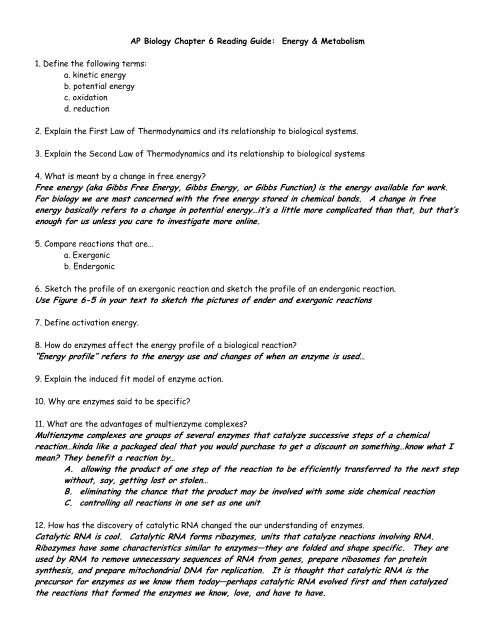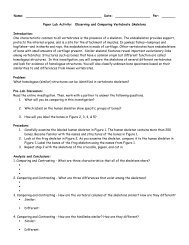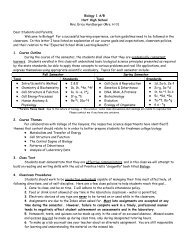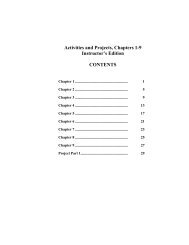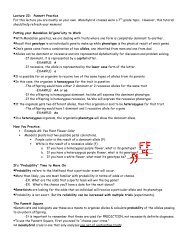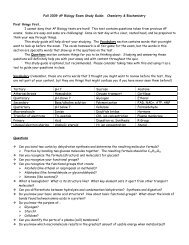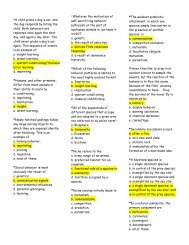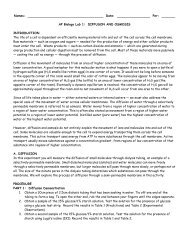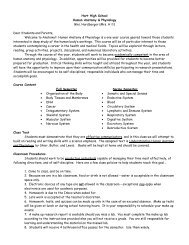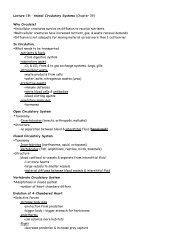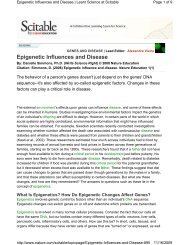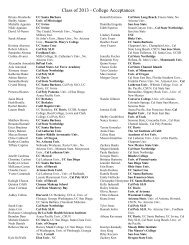AP Biology Chapter 6 Reading Guide: Energy & Metabolism 1 ...
AP Biology Chapter 6 Reading Guide: Energy & Metabolism 1 ...
AP Biology Chapter 6 Reading Guide: Energy & Metabolism 1 ...
You also want an ePaper? Increase the reach of your titles
YUMPU automatically turns print PDFs into web optimized ePapers that Google loves.
<strong>AP</strong> <strong>Biology</strong> <strong>Chapter</strong> 6 <strong>Reading</strong> <strong>Guide</strong>: <strong>Energy</strong> & <strong>Metabolism</strong><br />
1. Define the following terms:<br />
a. kinetic energy<br />
b. potential energy<br />
c. oxidation<br />
d. reduction<br />
2. Explain the First Law of Thermodynamics and its relationship to biological systems.<br />
3. Explain the Second Law of Thermodynamics and its relationship to biological systems<br />
4. What is meant by a change in free energy?<br />
Free energy (aka Gibbs Free <strong>Energy</strong>, Gibbs <strong>Energy</strong>, or Gibbs Function) is the energy available for work.<br />
For biology we are most concerned with the free energy stored in chemical bonds. A change in free<br />
energy basically refers to a change in potential energy…it’s a little more complicated than that, but that’s<br />
enough for us unless you care to investigate more online.<br />
5. Compare reactions that are…<br />
a. Exergonic<br />
b. Endergonic<br />
6. Sketch the profile of an exergonic reaction and sketch the profile of an endergonic reaction.<br />
Use Figure 6-5 in your text to sketch the pictures of ender and exergonic reactions<br />
7. Define activation energy.<br />
8. How do enzymes affect the energy profile of a biological reaction?<br />
“<strong>Energy</strong> profile” refers to the energy use and changes of when an enzyme is used…<br />
9. Explain the induced fit model of enzyme action.<br />
10. Why are enzymes said to be specific?<br />
11. What are the advantages of multienzyme complexes?<br />
Multienzyme complexes are groups of several enzymes that catalyze successive steps of a chemical<br />
reaction…kinda like a packaged deal that you would purchase to get a discount on something…know what I<br />
mean? They benefit a reaction by…<br />
A. allowing the product of one step of the reaction to be efficiently transferred to the next step<br />
without, say, getting lost or stolen…<br />
B. eliminating the chance that the product may be involved with some side chemical reaction<br />
C. controlling all reactions in one set as one unit<br />
12. How has the discovery of catalytic RNA changed the our understanding of enzymes.<br />
Catalytic RNA is cool. Catalytic RNA forms ribozymes, units that catalyze reactions involving RNA.<br />
Ribozymes have some characteristics similar to enzymes—they are folded and shape specific. They are<br />
used by RNA to remove unnecessary sequences of RNA from genes, prepare ribosomes for protein<br />
synthesis, and prepare mitochondrial DNA for replication. It is thought that catalytic RNA is the<br />
precursor for enzymes as we know them today—perhaps catalytic RNA evolved first and then catalyzed<br />
the reactions that formed the enzymes we know, love, and have to have.
13. Explain how temperature and pH influence the rate of enzyme reactions.<br />
a. temperature<br />
b. pH<br />
14. How do competitive and noncompetitive inhibitors differ in their enzyme interactions?<br />
15. What happens during allosteric inhibition?<br />
See “allosteric control” on page 106 of your textbook.<br />
16. Explain the role of cofactors.<br />
17. What is a coenzyme?<br />
18. How does ATP “store energy”?<br />
19. How does ATP “couple reactions”?<br />
Be sure to read pages 98-99 carefully before approaching this question. It totally makes sense, but your<br />
text doesn’t refer to “coupled reactions’ until the summary at the bottom of page 99.<br />
20. Define the following metabolic terms<br />
a. anabolism<br />
b. catabolism<br />
21. Explain how biochemical pathways could have evolved.<br />
Early biochemical reactions took place with organic molecules scavenged from the environment. Generally,<br />
reactions were simple, one-step events. But only organisms capable of synthesizing their own energy<br />
could survive. Gradually energy use reactions were probably coupled with energy production reactions.<br />
Photosynthesis is a great example of a process where energy production is coupled with energy use.<br />
During the light dependent reactions, the plant synthesizes energy it needs to make food products.<br />
During the light independent reactions, the ATP and other products are utilized to generate food<br />
molecules from fixed CO 2 .<br />
22. Describe feedback inhibition.


